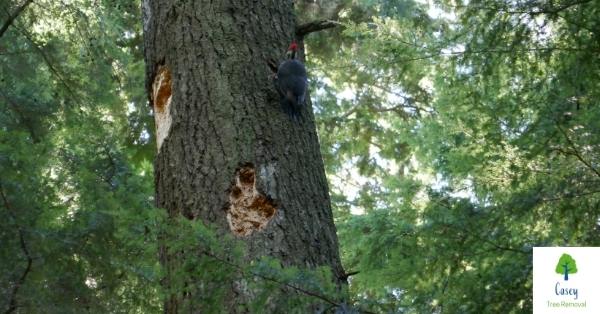While it is amazing to see how winter wildlife prepares and survives the brutal cold, snow, and ice of winters, it is also a nuisance in the spring to see how trees and animals affect each other in the winter. Animals such as deer, squirrels, rabbits, and chipmunks are just a few of the creatures active year-round and live in the cold.
During the spring and summer, we are often protecting those plants most susceptible to our gardens. We add wire around our hydrangeas and rose bushes to prevent deer from chomping on new growth, buds, and fully developed segments. Similarly, we inspect our gardens for holes and burrows where rabbits, moles, and voles are seeking inhabitance. We tend to take preemptive measures towards protecting our smaller plants, and often overlook protecting our trees in winter.
Rutting season or bark rubbing season?
During the early fall, male deer are on the move to partake in the rutting season. , it is no surprise that deer are one of the most prominent threats to your trees during Fall and early Winter. Rutting season is when male deer rub their antlers against trees in a ploy to wear off their velvet. Thin barked trees, such as birch and redbud are more susceptible to damage from deer than other trees.
If these thin-barked trees experience bark loss surrounding the entire circumference of a section of the trunk, they are more susceptible to girdling. If a tree experiences girdling, it is likely to die. Most trees can recover from this damage but will lose limbs above the aggravated area.
You’re probably wondering what girdling is exactly. Well, when an animal rubs the bark off the entire circumference of a tree, the energy transfers up and down the tree can be cut off.
Rabbits, Squirrels, Moles, and Voles Damage on Trees
Deer damage the upper half of the trunk, leaving the bottom half for those smaller animals to antagonize. The lower damage to a tree often goes unnoticed due to most of it occurring under the surface. Voles chewing on bark under the surface damage the tree drastically, so its health slowly declines. Rabbit damage is more noticeable, as they chew at bark above the surface level, and leave visible damage to the bark’s exterior.
With snow building up quickly in Melbourne, animal damage to the bottom of a tree’s trunk can go unnoticed. Voles animal damage is often not spotted due to its taking place below the surface. However, rabbits damage is spotted during the springtime, when external factors could’ve had the opportunity to threaten the health of your tree. We, at Casey Tree Removal, have means of protecting your trees all winter long. If you currently live on a property that receives several critter visitors, consider reaching out to our team of certified arborists. Our arborists will choose to either, make physical barriers, wrap your trees, or move the mulch around your tree. Each of these tactics will assist in protecting your trees from winter wildlife.
Casey Tree Removal – All Tree Services including Tree Cutting, Tree mulching, Tree Trimming, Stump Grinding, Tree Pruning, Stump Removal, Emergency Tree Removal Experts In Melbourne!
Click here to read more articles regarding tree removal & related services.
If you are in Hampton Park and looking for Casey Tree Removal, below is the best way to visit us.


Recent Comments